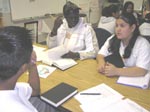
An East Oakland Odyssey
Exploring the Love of Reading in a Small School
Elena Aguilar, ASCEND. Oakland, CA
 |
|||
|
A TYPICAL LITERATURE CIRCLE CYCLEClick here to download as a PDF File: Typical Cycle DAY ONE1. Teacher chooses books to use If you plan to have 6 groups, chose 7-9 books to offer as options. I create groups of 3-4 students per group. Chose books that represent the range of reading skills in your class, as well as a range of genres of books. If possible, chose books that you have read or that students have read and recommend. One LC Cycle Reading List (8th Grade) 2. Book talk Take 1 copy of all the books you are offering to the front of the room and display them in front of you. Briefly describe the book and if you’ve read it, give your recommendation. You can also read all or part of the description on the back or reviews. The more excited you are about the book, the more excited the kids get. 3. Students look at books Set the books out on the desks and let students circulate and look at them. Remind them that they should read a few passages to assess whether the book is at their reading level or not. 4. Students select books Give students the book choice form and have them write down their top 4 choices of a book to read. , DAY 21. Teacher creates groups I try to create groups where skill levels are balanced and where student’s personalities are balanced. Students usually chose a novel that is appropriate to their reading level, but not always. This might be one reason why a student doesn’t get his/her top book choice. I also create groups that I know will have a strong facilitator, and a balance of talkers/listeners. Sometimes I intentionally create same-gender groups, depending on the book that will be read or the dynamics between students. When I know that certain students will only be successful and will only enjoy this experience if they are in a group where they feel supported and safe, then I make sure to create that kind of group. Students usually get their first or second choice of a book, but if they don’t then I promise them that the next time around, they’ll get the book they wanted. DAY 3 1. Teacher announces groups and distributes books For my own organizational purposes, I create a chart of students and groups. 2. Groups meet and create agreements for the group, the reading schedule, pages to read, and roles Groups sit together and first discuss the agreements they want to use in their group. Everyone begins with a standard set of rules that they can add to. Examples of added rules have been: don’t dominate the discussion, don’t speak in another language, (when there are members of the group who don’t speak that language) and don’t get off topic in the discussion. Students also decide consequences for not doing the reading for the meeting or forgetting your book. Sample LC Agreements Next students use a blank calendar that I give them to create their reading schedule. I tell them when they have to finish the book and when the meeting dates will be but they decide how many pages they want to read every night. This allows them to read more on the weekends, if they want, or to finish early if the book is short. This process needs to be facilitated in the beginning because there are often groups where the faster readers push to read the book at a rate that the others can’t handle. Students agree on what to read each night and where they’ll be by the time of the meetings and write in that information on the calendar. Calendar Finally, students decide which roles each one will play for the meetings. 3. Teacher distributes books DAY 3—211. Meetings Students typically meet for 2-3 weeks, two to three times a week. 2. Projects At the end of that time, they turn in projects based on their books. Sometimes they work on the projects during their regularly scheduled LC meeting time, sometimes they only have project timeas homework. Finally, projects are presented. Sometimes projects are presented to the whole class, sometimes projects are presented in small groups. See projects for more details. DAY 221. Student Reflection. Students reflect on the books they read and how their Literature circle group went. See reflections. 2. Teacher reflection and Assessment Teacher reflects on the LC cycle using the student’s reflections and the data that he/she has gathered during the cycle. Problem areas are identified and considered for the next cycle. Teacher also assesses student work and reflections for reading skills. |